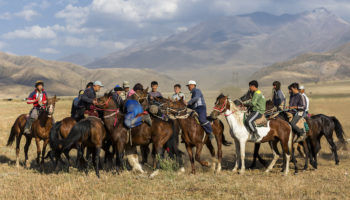The perfect introduction to the Middle East, Jordan has long been one of the region’s most popular countries to visit. While it is mostly known for the phenomenal ruins of Petra and the salty Dead Sea, there are plenty of other amazing things to experience. Aside from its ancient archaeological sites and epic desert landscapes, you can enjoy delicious local dishes and unforgettable Arab hospitality.
As it is located at the crossroads of Africa, Asia and Europe, the arid area east of the Jordan River has been ruled by countless civilisations over the millennia. Everyone from the Romans to the Umayyads and Ottomans left behind incredible old ruins. The most renowned of these is of course Petra. The country’s standout symbol, it was hewn out of solid rock by the Nabateans amidst rugged desert canyons.
Map of Places to Visit in Jordan
 © OpenStreetMap © MapTiler © Touropia
© OpenStreetMap © MapTiler © TouropiaNow known as the Hashemite Kingdom of Jordan, it is certainly one of the safest and most stable countries in the Middle East. As such, it now houses a large population of Palestinian, Iraqi and Syrian refugees. Its capital Amman has also grown enormously over the last few decades due to this. A mix of old and new, it makes a peaceful base for visiting the nearby Desert Castles and the Dead Sea.
Whether it is relaxing by the Red Sea, admiring ancient Roman ruins or exploring its atmospheric souks, there are plenty of interesting places to visit in Jordan. Add in its magnificent Middle Eastern cuisine and friendly, welcoming people and you’ll come away instantly wanting to return again.
In this post, we'll cover:
12. Umm Qais

Nestled away right in the very north of Jordan are the impressive and extensive ruins of Umm Qais. Fascinating to explore, they can be reached in roughly two hours from the capital with many day trips departing here. The sprawling archaeological site also has an excellent museum and outstanding views over the surrounding area to enjoy.
Thought to have been founded as a military colony by Alexander the Great’s troops, Gadara, as it was then known, dates to around the third century BC. During the Hellenistic and Roman periods, it acted as an important centre of Greek culture in the region.
Now lying in ruin, it has ancient temples, houses and a collonaded street for visitors to wander around. The highlight though has to be its terrific theatre made out of black basalt which is in remarkably good condition. According to the Bible, Umm Qais is where Jesus cast demons from men to pigs.
Asides from seeing statues, masks and mosaics uncovered here in its museum, you can gaze over the Sea of Galilee and Golan Heights from its prominent hilltop setting.
11. Wadi Mujib

While Wadi Rum understandably attracts the most attention, Wadi Mujib’s landscapes are every bit as awe-inspiring. Known as ‘Jordan’s Grand Canyon’, the gigantic gorge runs from the Desert Highway right the way to the Dead Sea. Other than ogling at its immense size and scale, you can try all kinds of fun outdoor activities here and even go wildlife watching too.
An important boundary line since Biblical times, it stretches about seventy kilometres in length. Cutting its way through the desert, the canyon plunges over a thousand metres in depth at its lowest point. The King’s Highway winds its way through part of it while the enormous Al Mujib Dam controls the river’s flow.
In the Mujib Biosphere Reserve that protects its western side, there is an exhilarating rappel down to its rushing waters. Besides clambering about its dramatic formations, you can sometimes spot animals and birds amidst its vast wilderness. These include Nubian ibex, striped hyenas and Egyptian vultures. We absolutely loved stopping off and exploring its rugged confines on our way from Amman to the Dead Sea.
10. Madaba

Also located alongside the King’s Highway in between Amman and Wadi Mujib is the ancient city of Madaba. Best known for its beautiful old Byzantine and Umayyad-era mosaics, its incredible archaeological parks are amazing to explore.
Scattered across the city, its millennia-old mosaics coat the floor of countless houses and churches. The most famous of these is certainly the sixth century ‘Madaba Map’ in the Basilica of Saint George. Its two million pieces of coloured stone impressively depict Jerusalem and the Holy Land in great detail.
After snapping pictures of this unique artwork, you can see more mosaics in its archaeological park and on-site museum. Other sights to amble around here are the ruins of Umm ar-Rasas, a former Roman military camp, and the atmospheric Church of the Apostles which dates to 578 CE.
Mount Nebo also lies just to the northwest and is often visited together with Madaba as part of day trips. Said to be the place where Moses gazed over the Promised Land just before his death, the mighty ridge offers up divine views over the Jordan Valley. A number of magnificent mosaics, the Moses Memorial Church and a Serpentine Cross can also be found here.
9. Dana Nature Reserve

For those looking to see more of the country’s spellbinding landscapes and scenery, the Dana Nature Reserve is the perfect place to go. Amidst all its endless wilderness, you can hike for days and barely come across another soul. There is also a charming stone village and some comfy lodges to stay at, should you want to explore further.
Part of the Great Rift Valley which remarkably stretches to Africa, Jordan’s largest nature reserve encompasses four different bio-geographical zones. Alongside arid areas and sand dunes, you can see wind-cut sandstone cliffs scarring its soaring mountains. Plummeting gorges and fantastical rock formations only add to the drama of the scenery before you.
Crisscrossing its plateaus and valleys are plenty of picturesque paths for you to hike along. As you slowly make your way about the park you’ll spy Nubian ibex and Syrian serin amongst its sparse shrubs and hundreds of plant species.
Staying at the dilapidated Dana Village only completes the experience. Perched right at the edge of a steep cliff, its partially reconstructed houses have been around since Ottoman times. Its handful of hotels make a great base for exploring the region.
8. Aqaba

If instead of hardcore hiking, you want to swim, scuba dive or enjoy some other water sports, then Aqaba and its exciting adventure activities is a better bet. Lying along the Red Sea next to Eilat in Israel, the popular tourist destination also borders Egypt and Saudi Arabia.
Due to its strategic setting on the Gulf of Aqaba between Africa and Asia, it has been an important port for thousands of years. As such, some interesting historic sites also exist in town. These include the sixteenth century Aqaba Fort and the sparkling white Sheik Zayed Mosque. You can also marvel at the ruins of the ancient Aqaba Church. Considered the world’s first purpose-built Christian church, it dates to about 300 AD.
After the stifling heat of the desert, its twinkling turquoise waters offer some welcome respite. In addition to relaxing at top-class hotels, on the beach or being pampered at hammams, you can snorkel and scuba dive in the Red Sea. The coastal city also has sightseeing cruises to take above its all rich marine life and colourful coral reefs.
7. Al-Karak

If you’re interested in castles, then Al-Karak is definitely worth a visit. The city of Al-Karak, also known as just Karak or Kerak, is located in Southern Jordan. It is known for its significant Christian population as well as its amazing castle. Al-Karak is home to the Citadel of Kerak, which was once a Crusader stronghold.
After being ransacked, the castle was left in ruins for nearly 500 years. Some restoration work has taken place, and you can tour the castle to see the parts that have been restored. In the lower portion of the castle is the Karak Archaeological Museum, which boasts an impressive collection that helps explain more about the region’s history.
6. Amman

Often derided (unfairly we think) for being boring, Jordan’s capital Amman is a lovely city to spend a few days. For such a massive, modern metropolis, it has many calm, quiet neighborhoods with most of its main attractions lying within walking distance of one another.
One of the oldest continuously inhabited places on Earth, it has a number of ancient historic sites dotted about. Its crumbling citadel for instance was settled 12,000 years ago with Roman, Byzantine and Umayyad ruins still occupying its hilltop. From here, you can look out over the whole city stretching away before you. Down below is also a well-restored Roman theater to clamber about, cut into the side of another hill.
After seeing its two main sights, make your way to the nearby Rainbow Street for a radical change of scene. Rather than age-old ruins, the popular promenade has tons of trendy rooftop restaurants, streetside cafes and cool shops to check out. If you’re after even more shopping, then the more traditional Souk Mango is the place to go.
Unlike many other capitals in the Middle East, we found Amman surprisingly peaceful and relatively easy to get around. Its interesting history, excellent food and extensive shopping options made it the perfect base for seeing the rest of the country.
5. Desert Castles

Scattered about the semi-arid regions of northeastern Jordan are numerous old forts and palaces known as the Desert Castles. Fascinating to explore, they usually lie in isolated spots, alongside oases and what were once important trading routes. If you rent a car or arrange a tour, you can easily visit quite a few in just a single day while driving along the Desert Castle Loop.
Erected by the Umayyads around the seventh century, the castles typically consist of a fortified complex, including a mosque, bathhouse and other buildings. Either used as hunting lodges or military outposts, the main residence was usually decorated with marvellous mosaics, frescoes and reliefs.
Particularly impressive are those of Qasr Amra and Qasr Hallabat as both showcase some beautiful frescoes and mosaics. The castle-like Qasr Harana is also well worth checking out as is Qasr Azraq. Aside from exhibiting some outstanding architecture, it was here in 1917-1918 that T.E. Lawrence based himself during the Arab Revolt.
4. Dead Sea

Although most of Jordan is landlocked, it does share one small piece of coast with the Dead Sea. The Dead Sea is the lowest point on the planet, 430 meters (1,400 feet) below sea level, and the salinity level is incredibly high. The Dead Sea also has a number of historic and religious ties, and it was the site where the Jesus was allegedly baptized by John the Baptist.
It is also an amazing place for relaxation, because the water is full of minerals and the high salinity makes it easy to float on your back. The best way to visit the Dead Sea is to stay at one of the luxury resorts at the northeastern end of the sea. Here you can enjoy a spa treatment, watch the sunset across the water and even see the night lights of Jerusalem.
3. Jerash

Even bigger and better preserved than those of Umm Qais are the remarkable ruins of Jerash. One of the most popular places to visit in Jordan, the almost endless archaeological site has countless temples, plazas, theaters and streets to stroll about. Lying in the north of the country, forty-five minutes from Amman, it really is a must for history lovers.
While the earliest ruins uncovered here date to 7,500 BC, the ancient city flourished from the 1st to the 7th centuries under the Romans. They constructed lots of massive monuments with Hadrian’s Arch and the Hippodrome being particularly astonishing to see. Other highlights include the colossal colonnades of its Forum and the stunning stage of the South Theatre.
To understand all that you’re seeing, it’s a good idea to go with a guide. We went with a local archaeologist who explained in great detail how the large city once functioned, as well as its rise, fall and ongoing excavations.
Even without any explanations though you’re guaranteed a lovely time as the Roman ruins are just so immense and extensive. Ambling about its Temple of Zeus and Oval Plaza while snapping photos of everything ended up being one of our favorite things we did in the country.
2. Wadi Rum

In Southern Jordan is Wadi Rum, a desert valley known for its breathtaking scenery. There are no permanent settlements in this secluded desert region, but Bedouins and nomadic tribes do occasionally pass through. Although deserts are often imagined as dunes, Wadi Rum boasts sandstone mountains and towering granite cliffs.
Many of the major attractions in Wadi Rum are natural landmarks and rock formations as well as unique colors of sand or rock. The Umm Fruth Rock Bridge, for instance, is truly remarkable to behold in person.
The distinctive reddish-orange colors that lend the area an otherworldly quality has brought severals science-fiction films here (such as The Martian) to replicate the Red Planet. Lawrence of Arabia also spent time in Wadi Rum, so you can tour places like his house and what is known as Lawrence’s Spring.
1. Petra

The best place to visit in Jordan, and now one of the new Seven Wonders of the World, is the ancient city of Petra. Also known as the Red City or the Rose City, Petra was once the capital of the Nabataean Kingdom before becoming part of the Roman Empire. The settlement was abandoned and forgotten for centuries by the Western world, but it was rediscovered in the 19th century.
Today, a visit to Petra allows you to tour the ancient archeological park, entering through the sandstone canyon known as Siq. After the Siq is the magnificent Treasury, which was actually not a treasury but probably a temple or a royal tomb.
Other significant ruins include the Roman Theater, The Monastery and the Street of Facades, a huge canyon bordered with the facades of assorted tombs. For the most spectacular views, hike to the Mountain of Aaron, which allows you to look down on Petra and its amazing rock-cut architecture.





The city of salt about 30 km north of Amman has a unique architecture , the buildings has about more than 20 style of doors windows and the allys also the allys captures the past beauty.
It has a captivating mosque and churches. The mayor aiming at placing it as national and world city